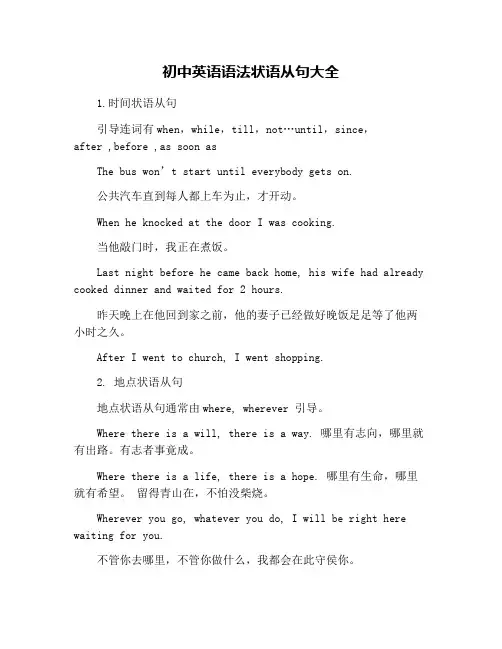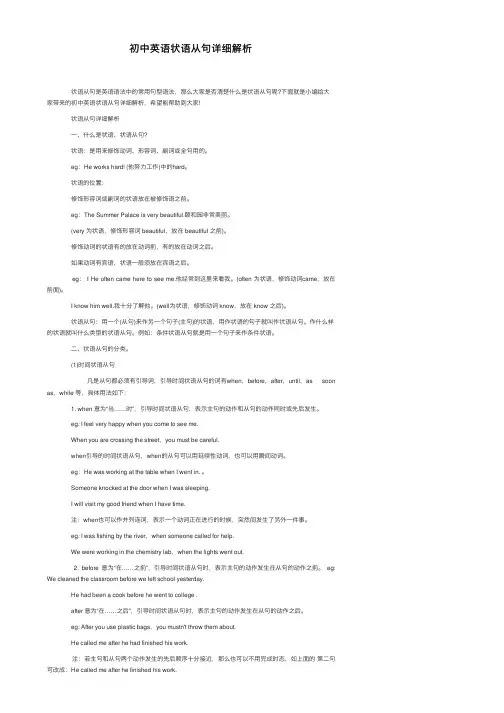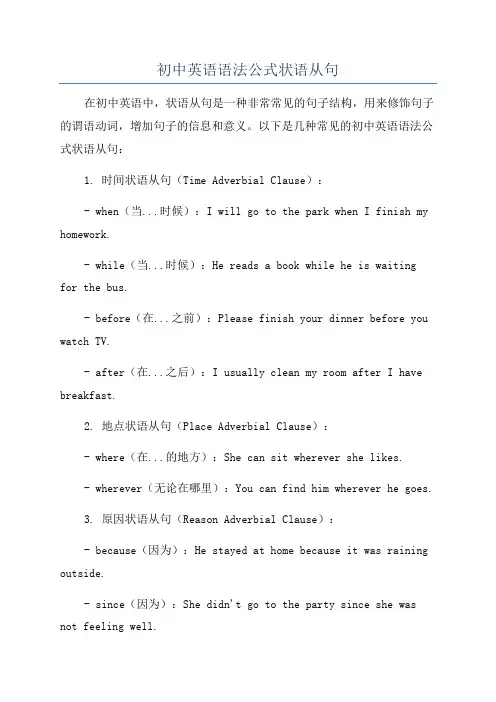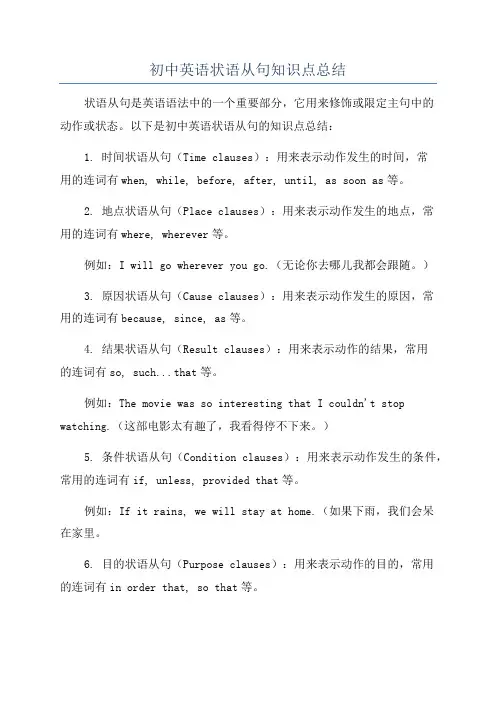初中英语语法大全——状语从句
- 格式:docx
- 大小:81.38 KB
- 文档页数:13

初中英语语法状语从句大全1.时间状语从句引导连词有when,while,till,not…until,since,after ,before ,as soon asThe bus won’t start until everybody gets on.公共汽车直到每人都上车为止,才开动。
When he knocked at the door I was cooking.当他敲门时,我正在煮饭。
Last night before he came back home, his wife had already cooked dinner and waited for 2 hours.昨天晚上在他回到家之前,他的妻子已经做好晚饭足足等了他两小时之久。
After I went to church, I went shopping.2. 地点状语从句地点状语从句通常由where, wherever 引导。
Where there is a will, there is a way. 哪里有志向,哪里就有出路。
有志者事竟成。
Where there is a life, there is a hope. 哪里有生命,哪里就有希望。
留得青山在,不怕没柴烧。
Wherever you go, whatever you do, I will be right here waiting for you.不管你去哪里,不管你做什么,我都会在此守侯你。
3.原因状语从句引导连词有because,as, since。
He didn′t see the film because he had seen it.他没有看那部电影,因为他已经看过了。
They couldn’t get on the train,for it was too crowed.比较:because, since, as和for1) because语势,用来说明人所不知的原因,回答why提出的问题。

初中英语状语从句详细解析 状语从句是英语语法中的常⽤句型语法,那么⼤家是否清楚什么是状语从句呢?下⾯就是⼩编给⼤家带来的初中英语状语从句详细解析,希望能帮助到⼤家! 状语从句详细解析 ⼀、什么是状语、状语从句? 状语:是⽤来修饰动词、形容词、副词或全句⽤的。
eg:He works hard! (他努⼒⼯作)中的hard。
状语的位置: 修饰形容词或副词的状语放在被修饰语之前。
eg:The Summer Palace is very beautiful.颐和园⾮常美丽。
(very 为状语,修饰形容词 beautiful,放在 beautiful 之前)。
修饰动词的状语有的放在动词前,有的放在动词之后。
如果动词有宾语,状语⼀般须放在宾语之后。
eg: I He often came here to see me.他经常到这⾥来看我。
(often 为状语,修饰动词came,放在前⾯)。
I know him well.我⼗分了解他。
(well为状语,修饰动词 know,放在 know 之后)。
状语从句:⽤⼀个(从句)来作另⼀个句⼦(主句)的状语,⽤作状语的句⼦就叫作状语从句。
作什么样的状语就叫什么类型的状语从句。
例如:条件状语从句就是⽤⼀个句⼦来作条件状语。
⼆、状语从句的分类。
(1)时间状语从句 凡是从句都必须有引导词,引导时间状语从句的词有when,before,after,until,as soon as,while 等,具体⽤法如下: 1. when 意为“当……时”,引导时间状语从句,表⽰主句的动作和从句的动作同时或先后发⽣。
eg: I feel very happy when you come to see me. When you are crossing the street,you must be careful. when引导的时间状语从句,when的从句可以⽤延续性动词,也可以⽤瞬间动词。



初中英语语法之状语从句类型及考点讲义状语从句概念解析状语从句指句子用作状语时,起副词作用的句子,可以修饰谓语、非谓语动词、定语、状语或整个句子,可分为时间、地点、原因、条件、目的、结果、让步、方式和比较等从句,是英语复合句学习的一个重点,在各类考试中都会经常出现,这次就来给大家讲解一下什么是状语从句。
1. 时间状语从句:常用引导词:when, as, while, as soon as, before, after, since , till, until特殊引导词:the minute, the moment, the second, every time, the day,the instant, immediately , directly, no sooner … than, hardly …when, scarcely … when instantlyI ran into the classroom as soon as the bell rang.2. 地点状语从句:常用引导词:where特殊引导词:wherever, anywhere, everywhereWherever the sea is , you will find seamen.3. 原因状语从句:常用引导词:because=in that, since=now that, as, for特殊引导词:seeing that, now that, in that, considering that, given thatI 'm late because I didn't caught the bus.4. 目的状语从句:常用引导词:so that, in order that特殊引导词: for fear that(唯恐/生怕),in the hope that, for the purpose that, to the end thatYou should book the hotel in advance so that the travel will be more easy.5.结果状语从句:常用引导词:so … that, such … that特殊引导词:such that, to the degree that, to the extent that, to such a degree thatHe is so young that he can't have meal by himself.6. 条件状语从句:常用引导词:if, unless,特殊引导词:as/so long as(只要), only if, providing/provided that(倘若), supposing that(倘若), in case that(以防), on condition thatYou can go to London as long as you have passport.7.让步状语从句:常用引导词:though, although, even if, even though特殊引导词: as(用在让步状语从句中必须要倒装),while,no matter …, in spite of the fact that, whatever, whoever, wherever, whenever, however, whichever, as if=as thoughThough we are old, we still can do these by ourselves.8. 比较状语从句:常用引导词:as(同级比较), than(不同程度的比较)特殊引导词:the more …the more …; just as …,so…,no … more than; not A so much as BShe is as pretty as her mother.9. 方式状语从句:常用引导词:as, as if, how特殊引导词:the wayHe didn't so it the way his brother did.辨析:while,when,as三者引导的时间状语从句时间状语从句算是状语从句中最简单的一类,也是我们日常生活交流中最常用的一类,虽然难度不大,但引导词也不少,仍然有不少同学会弄混那几个常见引导词的用法,这次就为大家带来as,when,while这几个词的辨析方法,一起看看吧。

初中英语知识点归纳状语从句的分类和用法状语从句是英语语法中重要的一部分,它用来修饰主句的动作或描述情况的,在句子中起着状语的作用。
状语从句分为时间状语从句、条件状语从句、原因状语从句、目的状语从句、结果状语从句、方式状语从句和比较状语从句等。
下面将对初中英语中常见的状语从句分类和用法进行归纳。
一、时间状语从句时间状语从句用来表示动作或事件发生的时间,包括连词when (当...时候),while (在...时候),before (在...之前),after (在...之后),as (当),since (自从),until (直到)等。
时间状语从句一般放在主句之前或者之后。
例如:- When I was young, I used to play soccer with my friends. (当我年轻的时候,我常常和朋友们踢足球。
)- After she finished her homework, she went to bed. (她完成作业之后,去睡觉了。
)二、条件状语从句条件状语从句用来表示主句动作的条件或前提,包括连词if (如果),unless (除非),in case (以防),as long as (只要),provided/providing (只要)等。
条件状语从句一般放在主句之前。
例如:- If it rains tomorrow, we will stay at home. (如果明天下雨,我们就在家呆着。
)- Unless you work hard, you won't pass the exam. (除非你努力学习,否则你就不能通过考试。
)三、原因状语从句原因状语从句用来表示主句动作或情况的原因,包括连词because (因为),as (因为),since (因为),for (因为),now that (既然)等。
原因状语从句一般放在主句之前。
例如:- Because it was raining, we stayed at home. (因为下雨,我们呆在家里。

初中英语语法公式状语从句在初中英语中,状语从句是一种非常常见的句子结构,用来修饰句子的谓语动词,增加句子的信息和意义。
以下是几种常见的初中英语语法公式状语从句:1. 时间状语从句(Time Adverbial Clause):- when(当...时候):I will go to the park when I finish my homework.- while(当...时候):He reads a book while he is waiting for the bus.- before(在...之前):Please finish your dinner before you watch TV.- after(在...之后):I usually clean my room after I have breakfast.2. 地点状语从句(Place Adverbial Clause):- where(在...的地方):She can sit wherever she likes.- wherever(无论在哪里):You can find him wherever he goes.3. 原因状语从句(Reason Adverbial Clause):- because(因为):He stayed at home because it was raining outside.- since(因为):She didn't go to the party since she was not feeling well.4. 条件状语从句(Conditional Adverbial Clause):- if(如果):If it rains tomorrow, we will stay at home.- unless(除非):You can't go outside unless you finish your homework.5. 方式状语从句(Manner Adverbial Clause):- as(如同):She ran as fast as she could.- like(像):He dances like a professional.这些状语从句的使用可以丰富句子的表达,使句子更加清晰明了。

初中英语状语从句知识点总结状语从句是英语语法中的一个重要部分,它用来修饰或限定主句中的动作或状态。
以下是初中英语状语从句的知识点总结:1. 时间状语从句(Time clauses):用来表示动作发生的时间,常用的连词有when, while, before, after, until, as soon as等。
2. 地点状语从句(Place clauses):用来表示动作发生的地点,常用的连词有where, wherever等。
例如:I will go wherever you go.(无论你去哪儿我都会跟随。
)3. 原因状语从句(Cause clauses):用来表示动作发生的原因,常用的连词有because, since, as等。
4. 结果状语从句(Result clauses):用来表示动作的结果,常用的连词有so, such...that等。
例如:The movie was so interesting that I couldn't stop watching.(这部电影太有趣了,我看得停不下来。
)5. 条件状语从句(Condition clauses):用来表示动作发生的条件,常用的连词有if, unless, provided that等。
例如:If it rains, we will stay at home.(如果下雨,我们会呆在家里。
6. 目的状语从句(Purpose clauses):用来表示动作的目的,常用的连词有in order that, so that等。
例如:I bought a new notebook so that I can take notes in class.(我买了一个新笔记本,这样我可以在课堂上记笔记。
)7. 方式状语从句(Manner clauses):用来表示动作发生的方式,常用的连词有as, as if, as though等。
例如:He speaks as if he knows everything.(他说话的样子就像他什么都知道。



初中英语语法学习之状语从句精讲英语状语从句是英语学习中的一个重要考点,下面将针对英语状语从句进行考点归纳。
一、时间状语从句时间状语从句是语法中的一个重要考点,下面是一些常见的时间状语从句:when:表示某个时间点或时间段,如“I will arrive at the airport when the plane takes off.”before:表示某个时间点或时间段之前,如“I will eat breakfast before I go to work.”after:表示某个时间点或时间段之后,如“I will finish my homework after I have dinner.”while:表示某个时间点或时间段持续,如“I was studying while she was sleeping.”as soon as:表示某个时间点或时间段一过去就发生,如“I will call you as soon as I get home.”until:表示某个时间点或时间段一直持续,如“I won't leave until I have finished my work.”since:表示某个时间点或时间段以来,如“I have been living in this city since I moved here last year.”when/while/as:这些词都可以引导时间状语从句,但它们的使用略有不同,需要根据具体语境选择使用哪个。
需要注意的是,如果主句是一般将来时,从句只能用一般现在时,如“I will go to the store tomorrow”中的“tomorrow”就是时间状语从句。
二、地点状语从句地点状语从句是语法中的一个重要考点,下面是一些常见的地点状语从句: where:表示某个地点,如“I will go to the store where I bought the groceries.”that:表示某个地点或位置,如“I saw a beautiful sunset over that mountain.”which:表示某个地点或位置,如“The building which is on fire needs to be evacuated immediately.”where/that/which:这些词都可以引导地点状语从句,但它们的使用略有不同,需要根据具体语境选择使用哪个。
状语从句状语从句用来修饰主句中的动词,副词和形容词的从句叫状语从句。
根据其含义状语从句可分为时间状语从句,地点状语从句,条件状语从句,原因状语从句,结果状语从句,比较状语从句,目的状语从句,让步状语从句。
1. 时间状语从句(1)时间状语从句常用when, as, while, before, after, since, till, until, as soon as等连词来引导。
例如:It was raining hard(rain hard 下大雨)when got to school yesterday.While he was doing his homework, the telephone rang.As he walked along(沿着走)the lake, he sang happily.He had learned a little Chinese before he came to China.After he finished middle school, he went to work in a factory.(2)在时间状语从句里,通常不用将来时态,用现在时态表示将来的动作或状态。
例如:I’ll ring you up as soon as I get to New York.I will tell him everything when he comes back.He won’t believe it until he sees it with his own eyes.(3)在带有till或until引导的时间状语从句的主从复合句里,如果主句用肯定式,其含义是“一直到……时”,谓语动词只能用延续性动词。
如果主句用否定式,其含义是“直到……才……”, “在……以前不……”, 谓语动词可用瞬间动词。
例如:The young man read till the light went out(熄灭).Let’s wait until the rain stops.We won’t start until Bob comes.Don’t get off(从下来)until the bus stops.【Till是指直到某一特定事件发生的时候,而在那个时刻之后,该事情或状况仍将持续。
中考英语语法复习状语从句知识讲解复合句由一个主句和一个或一个以上的从句构成,由连接词引导的句子是从句,另一句为主句。
在主从复合句中用作状语的从句叫作状语从句。
状语从句包括:时间状语从句、条件状语从句、原因状语从句、让步状语从句、结果状语从句、比较状语从句一、时间状语从句1.when 和 while 当……时1)when可以用来表示将来的某个时间会发生的事情或动作,主句用一般将来时,从句用一现在时(即"主将从现”)。
【例句】When spring comes, I'll work hard like you.当春天来临时,我将像你一样努力工作。
(由when引导的句子是从句,用一般现在时,spring是第三人称单数,用comes;另一句是主句,用一般将来时will work)特别提示:从句放在主句前面时,需要加逗号。
2) when 可以用来表示规律或客观真理,此时主句和从句都用一般现在时。
【例句】When water boils, it turns into steam.当水沸腾时,就会转变成水蒸气。
3)when 可以用来表示先后发生的两个动作,这两个动作都用一般过去时。
【例句】Lucy turned on the radio when she went back home.露西回到家就打开了收音机。
(露西回到家之后打开收音机,两个动作有先后)4)when可以用来表示一个动作(一般过去时)发生的时候,另一个动作(过去进行时)正在进行,此时 when 和 while可以互换使用。
【例句】When Ben was walking with Sam in the street, a motorcycle came towards Ben and knocked him down.当本和萨姆在街上走时,一辆摩托车冲过来,把本撞倒了。
(摩托车冲过来的时候本正在走路,所以"冲过来"用一般过去时,"正在走路"用过去进行时) 特别提示while引导的从句常用过去进行时,主句则用一般过去时。
一,状语从句状语从句在主从复合句中修饰主句中的动词、形容词或副词等,起副词的作用。
状语从句由从属连词引导,从属连词在从句中不担任任何句子成分。
状语从句可位于主句之前,也可位于主句之后。
位于主句之前,一般要加逗号与主句分开;位于句末则不需要。
状语从句根据它所表达的意思可分为时间、地点、原因、目的、结果、比较,让步、方式和条件状语从句等类。
(一),时间状语从句引导时间状语从句的从属连词有:when, while, as soon as, before, after, since , till, until 等【注】1,until (till) 直到,在用until 表达时间状语的句子中,主句中的动词是要十分小心去选择。
如动词是持续性动词,它要用肯定句,如:I studied hard until 12 o'clock last night. 如果动词是瞬间截止性动词,则要用否定句,即,not---until “直到…才”。
如:He didn't go to bed until his mother came back.They didn’t stop until they finished t he work .2,时间状语从句中的谓语动词不能用,将来时,终能用一般现在时表示一般将来时,即“主将从现”原则。
如,When he comes, I’ll tell him about it.I will call you as soon as I arrive in Beijing. 我到北京就将给你打电话(二),条件状语从句通常由从属连词if,unless等引导【注】1,条件状语从句与时间状语从句一样,从句中不能用将来时态,要用一般现在时态表示一般将来时态,也符合“主将从现”原则。
如,If it snows tomorrow, we will build a snowman.If it rains, they won't go to the park on SundayI won’t go to his party unless I am invited .,2,要区别是条件、时间状语从句还是宾语从句,因为在宾语从句中该用什么时态用什么时态,如:I want to know if he will come here tomorrowI want to know if it will rain tomorrow. If it doesn’t rain, I will go hiking.I don’t know when he will come, When he comes, I’ll tell him about it.(三),让步状语从句通常由从属连词though(although)(虽然,尽管),even if(even though)(即使)等引导注:翻译是后半句带有转折的意味,但不能由but连接。
初中英语知识点归纳常用的状语从句和状语从句句型状语从句是英语语法中常见且重要的一部分。
了解常用的状语从句和句型能够帮助初中学生更好地理解和运用英语语言。
本文将归纳常用的状语从句和状语从句句型,并且给出一些例句来帮助读者更好地理解。
1. 时间状语从句(Time clauses):时间状语从句用来描述一个动作或事件发生的时间。
常用的引导词有when, while, as soon as, before, after, until等。
例句:- You can go out to play when you finish your homework.- He called me while I was cooking dinner.- As soon as she arrived, the party started.- Before you leave, don't forget to turn off the lights.- After she finished her work, she went to bed.- I will wait until you come back.2. 地点状语从句(Place clauses):地点状语从句用来描述一个动作或事件发生的地点。
常用的引导词有wherever, wherever, anywhere等。
例句:- You can sit wherever you like in the classroom.- Let's go out and have a picnic wherever the weather is nice.- She can find her keys anywhere except in her bag.3. 原因状语从句(Reason clauses):原因状语从句用来描述一个动作或事件发生的原因。
常用的引导词有because, since, as等。
初中英语语法大全——状语从句在句中起状语作用的从句叫作状语从句。
状语从句可以位于句前、向中成向居。
位于句首时,常用迅号与主句隔开,位于句中时以句前后须用过号,位于句居时,从句的前面可以不用逗号。
状语从句主要包括时间状语从句地点状语从句、条件状语从句、原因状语从句、目的状语从句、结果状语从句、让步状语从句方式状语从句和比较状语从句。
一、时间状语从句引导时间状语从句的从属连词主要有when( ..时候),while( ...时候),as( ...时候), before(在...之前),after(在....之后),until/till(直到......),... since( ...以来),as soon as(一.......就......)等。
在时间状语从句中,要注意时态一致。
1.when, while和as的用法(1) when, while和as的共同用法when, while和as都可以引导时间状语从句,意为“当......时候”。
若表示主何中的动词和从句中的动作同时发生,而从句的谓语动词是延续性动词时,这三个词是等同的,可以互换。
eg: When/While/As we were dancing, a stranger came in. 当我们跳舞的时候,一个陌生人进来了。
eg: When/While/As I was taking a bath, the telephone rang. 我在洗澡的时候,电话响了。
(2) when, while和as的用法区别①when引导的时间状语从句的谓语动词既可以是延续性的,也可以是非延续性的,而while引导的时间状语从句的谓语动词只能是延续性的。
eg: When you came in, I was talking with a few boys. 你进来时,我正在和几个男孩子谈话。
eg: While we were waiting for the bus, it was raining heavily. 我们等公交车时,天正下着大雨。
②while和as常表示从句的动作与主句的动作同时发生,而when表示从句的动作发生在主句的动作之前、之后,也可同时发生。
eg: They rushed in while/as we were discussing problems. 当我们正在讨论问题时,他们冲了进来。
eg: When he had finished his homework, he took a short rest. 他写完作业后,休息了一会儿。
eg: When I got to the airport, the guests had left. 当我到达机场时,客人们已经离开了。
③while表示两个延续性动作同时发生而又有对比意义,主从句的时态通常是相同的。
eg: While she was making a phone call, I was writing a letter. 她打电话时,我正在写信。
eg: Eddie was sleeping while Millie was reading a magazine. 艾迪在睡觉而米莉在看杂志。
④as意为“随..... .... 边....”常用于表示两个动作同时或者几乎同时发生;表示两个发展变化中的情况;表示在某事发生的过程中另外一一件事发生;表示随着短暂动作的发生,另一动作立刻发生。
eg: As you older, you will know better and better about yourself. 随着年龄的增长,你会越来越了解自己。
eg: As he was reading , he was shaking his head. 他边读书边摇头。
2. as soon as的用法as soon as意为“一....就 ...”,表示从句的动作一发生,主句的动作随即发生。
eg: Mom, I'm leaving for Beijing tomorrow. --- That's nice. You'd better ring me up as soon as you get there. 妈妈,明天我将去北京。
--- 那很好。
你最好一到那里就给我打个电话。
eg: As soon as he heard the news, he jumped with joy. 一听到这个消息,他高兴地跳了起来。
2.since的用法(1) since意为“自从....”, 主句常用现在完成时或般现在时,从句常用一般过去时。
eg: I have lived in England since I was three. 自3岁起我就一直住在英国。
eg: It is two years since I became a college student. 我成为一名大学生已经两年了。
(2) 从句谓语不同,表达的意义不同。
① since引导的从句的谓语如果是延续性动词成者表示状态的动词,则从句表示的时间是从该动作或状态结束时算起。
eg: It has been a year since he worked here. 他不在这里工作已经一年了。
eg: He has written to me regularly since he was ill.自从病好以来,他定期给我来信。
② since引导的从句的谓语如果是延续性动词,则从句表示的时间是从该动作开始的那刻算起。
eg: We haven't seen each other since we parted. 自从分手以后我们一直没有见过面。
eg: We have been good friends since we joined the team. 自从加入这个队以来,我们就成了好朋友。
③ It is/has been..since句式“It is/has been+时间段since从句”句式表示“自...以来有(多久)”。
since从句不可以用否定句。
eg: It is has been 5 years since we last met. 自从我们上次见面以来已经有5年了。
eg: It has been a long time sine Mary was ill. 玛丽病好很长时间了。
④ until /till的用法until/till意为“直到....为止”。
当主句为否定句时,常构成“not...until...”结构,意为“直到......才......”(1) 主句是否定句时主句如果是否定句,谓语动词需用非延续性动词,表示主句的云作到从句表示的时间点才开始。
eg: You can't leave until you have finished your homework. 家庭作业写完后你才能离开。
eg: I didn't know anything about it until you told me. 直到你告诉我,我才知道关于这件事情的一切。
(2)主句是肯定句时主句如果是肯定句,谓语动词需用延续性动词,表示主句的动作直到从句表示的时间点就结束。
eg: I will wait for you until/till you come back. 我会一直等,直到你回来。
eg: You may stay here until/till the rain stops. 你可以在这里一直待到雨停。
(3)用于句首时,常用until而不用tilleg: Until you told me, I had heard nothing of what happened.直到你告诉我以前,我一点都不知道出了什么事。
eg: Until the manager returns, nothing can be done. 经理不回来,什么也不能做。
5. before, after的用法before意为“.....之前”时,表示主句动作发生在从句动作之前。
after意为“.....之后”,表示主句动作发生在从句动作之后。
eg: Please turn off the lights before you leave the classroom. 请在离开教室前关上灯。
eg: He arrived after the game started. 比赛开始后他才到。
6. by the time 的用法by the time常用来指到某时间点为止,主句常用完成时态。
eg: By the time he was 12, he had travelled to more than 30 countries.到12岁为止,他已经去过30多个国家了。
eg: By the time I got outside, the bus had already left. 我到外面时,公交车已经开走了。
7. 名词短语引导时间状语从句的用法表示时间的名词短语有时也可以引导时间状语从句,常见的此类时间短语有the time the moment the minute the day the last time the second timeeach day every time next time any timeeg: The day he returned home, his father was already dead. 他到家的那天,他父亲已经去世了。
eg: He said he' d phone you the moment he got home. 他说他一到家就给你打电话。
eg: He was much better the last time I saw him. 上次我见到他时,他好多了。
eg: Every time I see him, he is working hard. 我每次见到他,他都在拼命地工作。
二、地点状语从句在句子中充当地点状语的从句称为地点状语从句。
引导地点状语从句的从属连词主要有where( ...地方), wherever(无论问处)等,表示地点方位。
eg: I found all the missing things where I left them. 我在丢东西的地方找到了所有丢了的东西。
eg: Where there is a will, there is a way. 有志者,事竟成。
eg: You are free to go wherever you like. 你可以随意到你喜欢的任何地方去。
eg: Wherever there is smoke, there is fire. 无火不生烟。